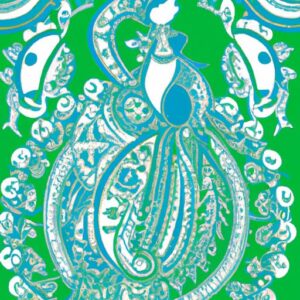El Salvador, a vibrant and culturally rich country, is home to a diverse range of traditional art forms that have been passed down through generations. In this article, we will delve into the captivating world of El Salvador traditional art and explore its significance in Salvadorian society.
A. Brief Overview of El Salvador’s Cultural Heritage
El Salvador’s cultural heritage is a tapestry woven with indigenous roots, colonial influences, and contemporary expressions. Located in Central America, this small yet captivating nation boasts a fascinating history that has shaped its artistic traditions. From the ancient Mayan civilization to the arrival of Spanish conquistadors, each chapter has contributed to the unique blend of cultural influences found in El Salvador today.
B. Importance of Traditional Art in Salvadorian Society
Traditional art holds a special place in Salvadorian society, serving as a powerful reflection of their identity, history, and values. It serves as a bridge between the past and present, preserving ancestral knowledge and traditions that might otherwise fade away. Through vibrant colors, intricate patterns, and skilled craftsmanship, traditional art serves as a visual language, communicating stories, beliefs, and cultural heritage.
Salvadorian traditional art forms encompass a wide range of mediums, including ceramics, textiles, and woodcarving. The mastery and dedication of Salvadorian artisans can be witnessed in their exquisite creations, which not only captivate the eye but also evoke a sense of pride and belonging.
As we embark on this exploration of El Salvador traditional art, let us embrace the opportunity to celebrate the creativity, cultural richness, and remarkable craftsmanship that characterizes this captivating aspect of Salvadorian heritage. Join me as we dive into the enchanting world of Salvadorian ceramics, textiles, and wood sculptures, uncovering the stories and traditions that have shaped this thriving artistic landscape.
Stay tuned for the next section as we delve into the history of traditional art in El Salvador, unearthing its fascinating evolution over time.
History of Traditional Art in El Salvador
A. Pre-Columbian Influences on Salvadorian Art
El Salvador’s rich artistic heritage can be traced back to its pre-Columbian roots, where indigenous civilizations left their indelible mark on the art forms of the region. The Mayan civilization, in particular, played a significant role in shaping Salvadorian art, leaving behind a legacy of architectural marvels, intricate pottery, and ornate textiles. The Mayans’ deep connection with nature and spirituality is evident in the motifs and symbols that adorn their artwork, showcasing their reverence for the natural world and their cosmological beliefs.
B. Evolution of Traditional Art Forms Over Time
Over the centuries, El Salvador’s traditional art forms have evolved and adapted, reflecting the influences of colonization, globalization, and modernization. The arrival of Spanish conquistadors in the 16th century introduced new materials, techniques, and artistic styles, resulting in a fusion of indigenous and European aesthetics.
The colonial period saw the emergence of religious art, with paintings and sculptures adorning churches and religious institutions. Salvadorian artisans skillfully incorporated indigenous motifs and techniques into their creations, creating a unique blend of artistic expression that celebrated both their heritage and the influence of Spanish colonialism.
In more recent times, Salvadorian traditional art has continued to evolve, embracing contemporary influences while still honoring its roots. Artists have found innovative ways to preserve and reinterpret traditional techniques, breathing new life into ancient art forms. This evolution has sparked a revival of interest in traditional art, both within El Salvador and beyond, as people recognize the beauty and cultural significance of these age-old practices.
As we delve deeper into the world of traditional art in El Salvador, we will explore the key art forms that have flourished over the years. Join me in the next section as we uncover the enchanting realm of Salvadorian ceramics, delving into the techniques and styles that make them truly remarkable.
Key Traditional Art Forms in El Salvador
El Salvador is a treasure trove of traditional art forms that showcase the immense talent and creativity of its artisans. Let’s explore the three key art forms that have played a central role in Salvadorian culture: ceramic art and pottery, textile art and weaving, and woodcarving and sculpture.
A. Ceramic Art and Pottery
Salvadorian pottery is a true testament to the artisanal skills and rich cultural heritage of the country. Utilizing techniques passed down through generations, Salvadorian potters create stunning pieces that reflect their unique artistic vision. From clay preparation to shaping and firing, every step in the pottery-making process requires precision and expertise.
- Techniques and Styles Used in Salvadorian Pottery
Salvadorian pottery encompasses a variety of techniques and styles, each with its own distinct characteristics. Traditional techniques include coiling, where long ropes of clay are stacked to form the desired shape, and slab construction, where flat pieces of clay are cut and joined together.
In terms of styles, you’ll find a diverse range of influences, from ancient Mayan patterns to colonial Spanish motifs. Vibrant colors and intricate designs are often featured, showcasing the artistic flair and attention to detail of Salvadorian potters.
- Significance of Pottery in Salvadorian Culture
Pottery holds deep cultural significance in Salvadorian society. Beyond its aesthetic value, it serves as a vessel for preserving traditions, stories, and beliefs. Many Salvadorian pottery pieces depict scenes from daily life, religious ceremonies, or mythical narratives, serving as a visual documentation of Salvadorian culture throughout history.
B. Textile Art and Weaving
Textile art is another integral part of El Salvador’s cultural fabric, with weaving techniques that have been honed over centuries. Salvadorian weavers skillfully transform threads into vibrant textiles that captivate the senses and carry profound symbolism.
- Traditional Weaving Techniques and Patterns
Salvadorian weavers employ various traditional weaving techniques, such as backstrap and pedal loom weaving. These methods allow for the creation of intricate patterns and designs, often inspired by nature, folklore, and ancestral traditions. The mastery of these techniques is passed down from one generation to the next, ensuring the preservation of this valuable cultural heritage.
- Symbolism and Cultural Significance of Textiles in El Salvador
Textiles in El Salvador are not merely decorative; they hold deep cultural significance. Each pattern, color, and motif carries symbolic meaning, telling stories of Salvadorian identity, spirituality, and history. From the vibrant “huipil” worn by Salvadorian women to the intricately woven blankets and rugs, textiles serve as a visual language, connecting individuals to their roots and instilling a sense of pride.
C. Woodcarving and Sculpture
Woodcarving and sculpture have long been celebrated art forms in El Salvador, embodying the artistic ingenuity and cultural heritage of the nation. Talented Salvadorian artisans transform blocks of wood into magnificent sculptures that depict religious figures, mythical creatures, and everyday scenes.
- Traditional Woodcarving Methods and Styles
Salvadorian woodcarvers employ both traditional hand tools and modern machinery to shape their creations. They utilize techniques such as relief carving, where figures are carved out from a flat surface, and chip carving, which involves removing small pieces of wood to create intricate patterns. The attention to detail and craftsmanship exhibited by Salvadorian woodcarvers is truly remarkable.
- Representation of Salvadorian Culture in Wood Sculptures
Wood sculptures in El Salvador often serve as a visual representation of Salvadorian culture, beliefs, and history. From religious icons that hold deep spiritual significance to sculptures depicting folkloric tales, these artworks offer a glimpse into the collective imagination and cultural heritage of the Salvadorian people.
Stay tuned for the next section as we explore the lives and contributions of prominent Salvadorian traditional artists, shedding light on their remarkable artistic journeys.
Prominent Salvadorian Traditional Artists
El Salvador has been blessed with a multitude of talented artists who have made remarkable contributions to the field of traditional art. These visionary individuals have dedicated their lives to preserving and enriching Salvadorian cultural heritage through their creative expressions. Let’s explore some of the notable Salvadorian traditional artists and the impact they have had on the art scene.
A. Notable Artists and Their Contributions to Traditional Art
-
Fernando Llort: Known as the father of Salvadorian naïve art, Fernando Llort’s vibrant and whimsical creations have captured the hearts of art enthusiasts worldwide. His distinctive style embodies the essence of Salvadorian culture, incorporating colorful depictions of rural life, flora, and fauna.
-
Beatriz de la Cueva: Revered for her exceptional skill in textile art, Beatriz de la Cueva has played a pivotal role in reviving and promoting Salvadorian weaving traditions. Her intricate designs, inspired by indigenous patterns, showcase the rich symbolism and cultural heritage of El Salvador.
-
Jose Antonio Velasquez: Renowned for his mastery in woodcarving, Jose Antonio Velasquez breathes life into Salvadorian folklore and mythology through his intricate sculptures. His works often depict traditional characters and stories, weaving together history and artistry.
B. Famous Salvadorian Art Schools and Their Impact on Traditional Art
Salvadorian art schools have played a crucial role in nurturing and fostering traditional artistic talents. These institutions provide aspiring artists with a platform to refine their skills and explore their creativity, ensuring the preservation and evolution of traditional art forms.
-
Escuela de Artes Aplicadas: Founded in 1943, this prestigious art school has been instrumental in promoting traditional art techniques, such as ceramics and pottery. It has produced numerous skilled artisans who continue to contribute to the Salvadorian art scene.
-
Escuela Nacional de Artes: With a focus on both traditional and contemporary art, the Escuela Nacional de Artes has been a breeding ground for Salvadorian artists across various disciplines. Their curriculum emphasizes the importance of preserving cultural heritage while encouraging innovation and experimentation.
Through the collective efforts of these remarkable artists and esteemed art schools, El Salvador’s traditional art scene continues to thrive and evolve. Their dedication to preserving cultural heritage and pushing artistic boundaries ensures that Salvadorian traditional art remains a vibrant and integral part of the nation’s identity.
Stay tuned for the next section as we delve into the preservation and promotion of El Salvador traditional art, exploring the initiatives taken to safeguard this invaluable cultural heritage.
Preservation and Promotion of El Salvador Traditional Art
A. Efforts to Preserve Traditional Art Forms in El Salvador
Preserving the rich heritage of El Salvador traditional art is a shared responsibility embraced by various individuals, organizations, and communities. Recognizing the importance of safeguarding these precious art forms, concerted efforts have been made to ensure their survival for future generations.
Artisans and communities play a vital role in the preservation of traditional art in El Salvador. Through their dedication and commitment, they pass down their knowledge and skills to younger generations, keeping the artistic traditions alive. These artisans often serve as custodians of cultural heritage, meticulously maintaining ancient techniques and craftsmanship that have been refined over centuries.
Moreover, cultural organizations and institutions have undertaken initiatives to document, research, and promote traditional art forms. By conducting extensive studies and collecting valuable artifacts, these organizations contribute to the preservation and documentation of Salvadorian traditional art. They also organize exhibitions and events that showcase the beauty and significance of these art forms, raising awareness and fostering appreciation among the wider public.
B. Role of Government and Cultural Organizations in Promoting Traditional Art
The Salvadorian government recognizes the value of traditional art as a cultural asset and has taken steps to support its preservation and promotion. Through funding programs, grants, and subsidies, the government encourages artisans and cultural organizations to continue their invaluable work. These initiatives provide financial assistance for the training of artisans, the establishment of workshops, and the development of sustainable practices.
Cultural organizations and NGOs also play a crucial role in promoting traditional art in El Salvador. They collaborate with artisans, communities, and government entities to organize workshops, festivals, and educational programs. By providing platforms for artists to showcase their creations, these organizations encourage public engagement and appreciation for Salvadorian traditional art.
The collective efforts of artisans, communities, government entities, and cultural organizations form a strong foundation for the preservation and promotion of El Salvador traditional art. By nurturing these art forms, we ensure that the cultural legacy of this remarkable nation continues to thrive and inspire generations to come.
Stay tuned for the final section as we conclude our exploration of El Salvador traditional art, reflecting on its significance and the importance of preserving cultural heritage.
Conclusion: Embracing the Beauty of El Salvador Traditional Art
In conclusion, El Salvador traditional art is not just a visual spectacle but a testament to the rich cultural heritage and artistic prowess of the Salvadorian people. Throughout history, the fusion of indigenous traditions, colonial influences, and contemporary expressions has given rise to a diverse array of art forms that continue to captivate and inspire.
From the intricate designs of Salvadorian pottery to the vibrant tapestries woven through traditional textiles, each art form tells a story, preserves ancestral knowledge, and showcases the creativity and skill of Salvadorian artisans. These artworks serve as a tangible link between past and present, connecting Salvadorians to their roots and fostering a sense of pride and belonging.
Preserving and promoting El Salvador traditional art is essential in ensuring that these valuable traditions are not lost to time. Efforts to safeguard these art forms, such as government initiatives and the work of cultural organizations, play a crucial role in maintaining the cultural fabric of El Salvador and nurturing the artistic talents of future generations.
As we embrace the beauty of El Salvador traditional art, let us appreciate the intricate details, the symbolism, and the craftsmanship that go into each piece. By supporting Salvadorian artisans, we can contribute to the preservation and continuation of these cherished traditions.
So, whether you’re admiring a delicate ceramic vase, marveling at the skillful weaving of a traditional textile, or contemplating the intricate details of a wooden sculpture, remember that El Salvador traditional art is more than just an artistic expression. It is a celebration of cultural heritage, a testament to human creativity, and a bridge that connects us to the past.
Let us continue to appreciate, celebrate, and support El Salvador traditional art, ensuring that these remarkable art forms continue to flourish and enchant generations to come.
Thank you for joining me on this journey through the captivating world of El Salvador traditional art. Stay curious, stay inspired, and may your own creative spirit be forever ignited.





